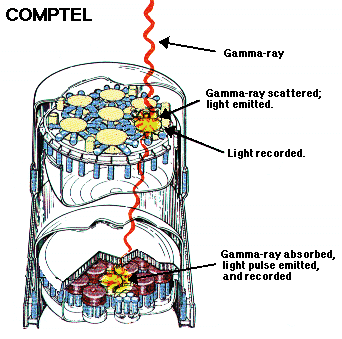Compton Scattering
The region from about 1 to 30 MeV is a difficult, but interesting, part of
the gamma-ray
astronomy
energy range. This is the region where nuclear
emission lines can be detected, and a region where some pulsars and
active galaxies are strongly detected. In addition, solar flares and
gamma-ray bursts can often be detected in this energy band.
It is also the energy range
where Compton scattering is the dominant physical interaction. Compton
scattering occurs when a photon "hits" an electron with some of the
photon energy being transferred to the charged particle. The Compton
Scatter Telescope uses this interaction as the basis of its detection
scheme.

Compton scatter telescopes have been largely experimental in design.
The most advanced and successful instrument is the so-called COMPTEL
(COMPton TELescope) aboard NASA's
Compton Gamma-Ray
Observatory.
Basic operating principles
Compton scatter telescopes are typically two-level instruments. In the
top level, the cosmic gamma-ray Compton scatters off an electron in
a scintillator. The scattered photon then travels down into a second
level of scintillator material which completely absorbs the scattered
photon. Phototubes viewing the two levels can approximately determine
the interaction points at the two layers and the amount of energy
deposited in each layer.

|
As shown in the picture above, the line between these two interaction
points does not point back to the direction of the incoming photon.
It is possible, however, to determine the angle of incidence the cosmic
photon made with respect to this line because the Compton scattering
law provides for a definite relationship between this angle and the
energy of the scattered photon (measured in the second level) and the
scattering electron (measured in the first level). Unfortunately, while
this angle is calculable, you cannot determine which azimuthal direction
the photon came from. As a result, the gamma-ray could have come from
anywhere in a ring on the sky, which makes analyzing Compton telescope
data particularly challenging. |

|
The operating principle of COMPTEL. An incoming photon enters
from above and Compton scatters in the first detection layer (blue),
then is (partially) absorbed in the second layer (green).
|
|
As with other instruments, careful anticoincidence and time-of-flight
techniques are needed to reduce the noise caused by cosmic rays.
Detector characteristics
Even large Compton-scatter telescopes have relatively small effective areas.
This is because only a small number of the incident gamma-rays actually
Compton scatter in the top level. So even if an instrument like COMPTEL
has a geometric area of several thousand cm2, the effective area
(weighted for the probability of an interaction) is a few tens of
cm2.
Energy resolution is fairly good for these detectors, typically 5-10%
This is limited by uncertainties in the measurements of the energy
deposited in each layer. Compton scatter telescopes have wide
fields-of-view and can form images even though the so-called point
spread function (the probability that an event came from a certain area
on the sky) is a ring.
Future developments
Current research on Compton telescopes is emphasizing ways of tracking the
scattered electron. By measuring the direction of the scattered
electron in the top level, a complete solution for the incoming
trajectory of the cosmic gamma-ray can be found. This would allow
Compton telescopes to have more conventional data analysis approaches
since the "event circle" would no longer exist.
|
